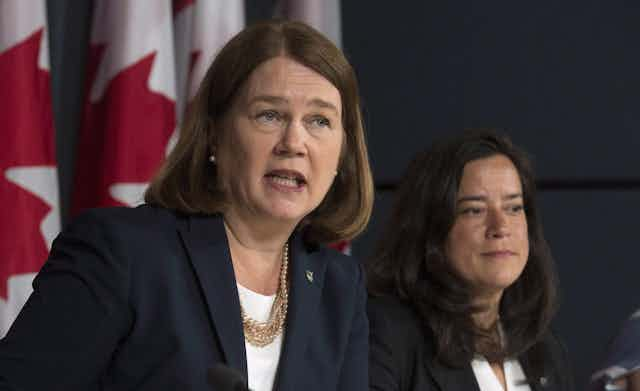Social media has made every day a huge news day. Responses to political developments are regularly framed in apocalyptic turns. It is not only a challenge to determine whether news is real or fake; all news is immediately contextualized as the 1927 Yankees of bombshells.
The Earth is scorched, the end is near, each new revelation has shades of Watergate.
The SNC-Lavalin saga is now more than a month old. The story has dominated the Canadian national news cycle for weeks; television political panels have been convened at a rate not seen since the days of Nigel Wright and Mike Duffy. Public opinion polls have started to reveal the impact of the scandal on voting intentions.
And because of the breathless coverage of the political fallout, it’s easy to overlook the resignations of Jody Wilson-Raybould and Jane Philpott as a truly historic cabinet event.
Based on one measure — the volume and timing of ministerial resignations — 2019 has been a historic year in Canadian federal cabinet governance. Yes, only two people resigned, but ministerial resignations on principle, policy or political strategy are rare. Multiple ministerial resignations on principle, policy or political strategy are unicorns.
Few cabinet resignations over disagreements
Since Confederation, almost 700 people have served in federal cabinet — only 26, or around four per cent, have resigned over disagreements with the government.

This type of resignation has become even rarer over time — Stephen Harper only had one, Paul Martin had one, Jean Chretien endured no resignations of this type and Brian Mulroney experienced two, most notably Lucien Bouchard’s departure over the Meech Lake accord, which led to the creation of the Bloc Québecois.
Bouchard’s case highlights that many of the 26 resignations have been, like the current controversy, steeped in political drama and intrigue. Pierre Trudeau lost a minister who tried to form his own party called Action Canada.
The Wilson-Raybould/Philpott resignations are historic because it is only the fourth time in Canadian history that a prime minister has lost multiple ministers as the result of a single decision or incident.

The first time is a favourite for Canadian history buffs. Short-serving prime minister Mackenzie Bowell described the seven ministers who resigned his cabinet in 1896 over their loss of confidence in Bowell as a “nest of traitors.” He was ultimately forced out of office over Catholic school rights in Manitoba.
The second time multiple ministers resigned in response to the same incident occurred in the Mackenzie King government during the 1944 conscription crisis. King’s decision-making on sending soldiers overseas led to the resignation of two ministers on opposite sides of the conscription debate, Chubby Power and James Ralston, although historians suggest the pro-conscription Ralston was forced to quit.
The third time, in February 1963 under Prime Minister John Diefenbaker, George Hees, Pierre Sevigny and Douglas Harkness resigned over the span of a week in response to the government’s position on housing nuclear missiles as part of NORAD.
Shows how cabinet works
Lumping in the 2019 cabinet resignations with Bowell, King and Diefenbaker may be notable in a trivial sense, but the incident has also provided ample information on how cabinet works, leading to many substantive debates.
In the last month, commentary has focused on how the media covers female ministers, the workings of cabinet and the history of women leaving Canadian cabinets.
Read more: Saying no to power: The resignations of women cabinet members
When Prime Minister Justin Trudeau announced in front of Rideau Hall in 2015 that “government by cabinet is back” he brought an unusual amount of attention to his government. His cabinet was much smaller than most modern federal cabinets, and was the most gender and racially diverse in Canadian history.
Trudeau promised not only changes at a descriptive level, but also operational — ministers would be more empowered than in previous cabinets during an era of increasing centralization of power in the Prime Minister’s Office. The high expectations have only proved to shine a brighter light on the current cabinet turmoil.

Across all levels of government in Canada, ministerial resignations on the basis of political, policy or principled disagreement with the government are unusual and remarkable (we should not forget the recent and incredible case of five provincial ministers resigning in Manitoba under Premier Greg Selinger).
A different type of cabinet
But as experts have noted, Trudeau’s is a different type of cabinet.
This means that while we should understand these resignations as historic, they could also do something entirely new: They could challenge the stubborn trends of strict cabinet solidarity and power struggles behind closed doors.
Due to cabinet confidentiality and ministerial oaths of secrecy, the institution of cabinet is one of the country’s most difficult to understand. It can take years, and after-the-fact insiders’ accounts, to gain a deeper understanding of the inner workings of a powerful institution.
While the Wilson-Raybould/Philpott resignations are historic by the numbers, they may also prove historic in creating a new faith in a previously elite and closed decision-making body that possesses a tremendous influence over the lives of Canadians.
This is a corrected version of a story originally published on March 12, 2019. The earlier story said Diefenbaker lost one minister over the nuclear weapons issue, but he in fact lost three.

